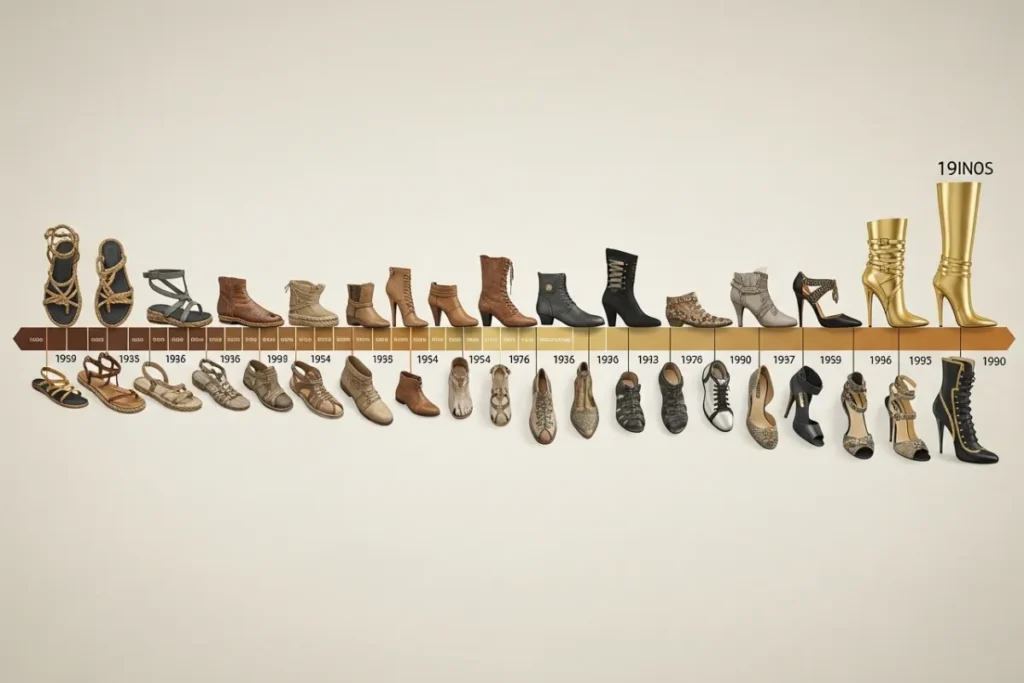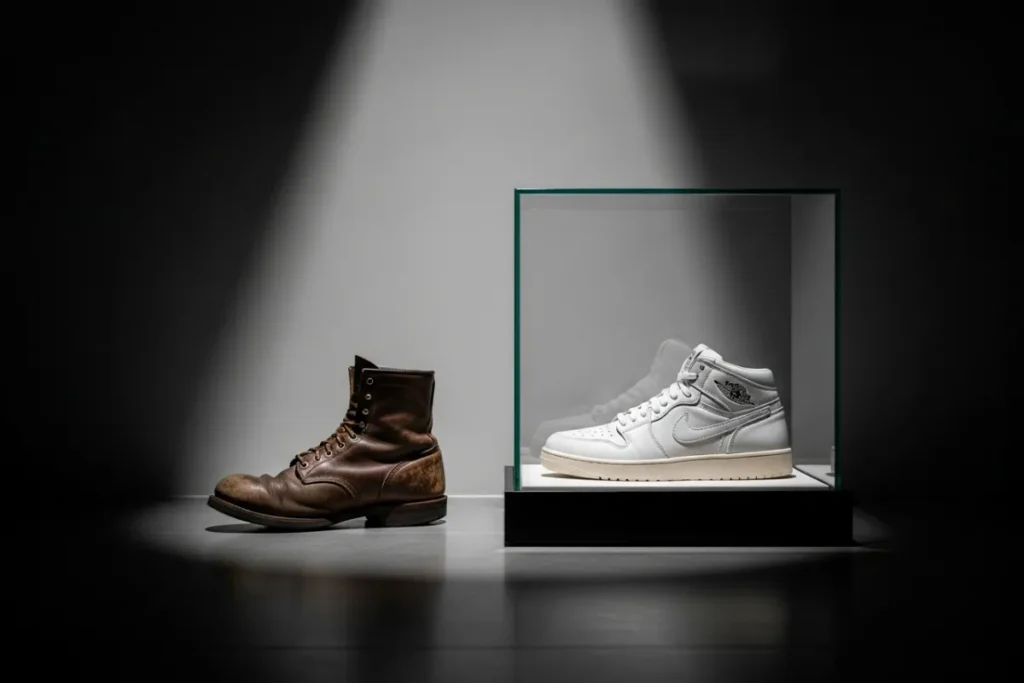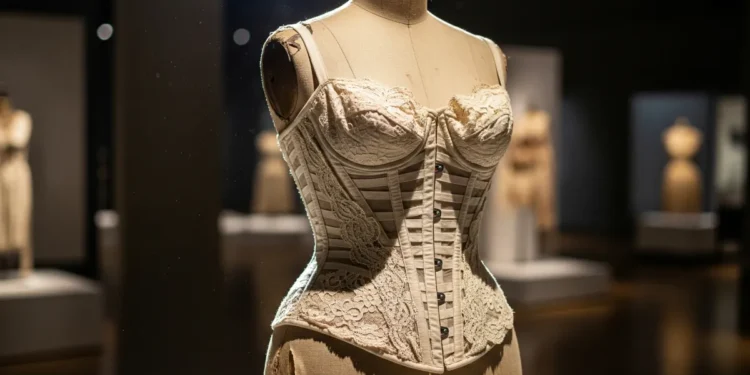Explore the cultural significance of shoes and class as powerful symbols of social status and identity. This blog post delves into the evolution of footwear from practical protection to luxury items that reflect societal values and class distinctions. Discover how branding, industrialization, and sustainability have transformed shoes into markers of status while also revealing personal narratives shaped by footwear choices. Learn how sneakers have become cultural equalizers, bridging economic divides, and highlighting the dynamic relationships between fashion, identity, and social dynamics.
Table of Contents
The Cultural Significance of Shoes And Class
Throughout history, shoes have evolved from mere protective gear for the feet to powerful symbols that reflect individual identity and societal values. In various cultures, footwear has often served as a barometer for social status, articulating a person’s place within the social hierarchy. For example, the distinction between functional everyday shoes and exquisite designer footwear illustrates the stark class divide prevalent in modern society. As shoes and class became an essential aspect of personal style, they have increasingly represented fashion inequality, with luxury brands positioning themselves as gatekeepers to exclusivity and prestige.
The evolution of footwear has been shaped by a myriad of factors, including technological advances and changing social norms. Early shoes were pragmatically designed for comfort and protection, but as societies progressed, so too did the meaning behind the shoes we wear. The cultural meaning of shoes and class extends beyond their functionality; they have become a canvas for self-expression, encompassing everything from subcultural identities to high-end fashion statements. In contemporary contexts, branding plays a pivotal role in reinforcing social status. Popular sneaker brands, for instance, often create a sense of belonging among consumers, while simultaneously highlighting the disparities between classes.
The intersection of shoes and social status is particularly pronounced in consumer culture, where the acquisition of fashionable footwear often signifies economic capability. This has led to an environment where the narrative surrounding labeled shoes and class highlights the class divide. Individuals often seek to enhance their social standing through the acquisition of high-end brands, reinforcing the idea that shoes are not simply an accessory but rather a reflection of one’s identity and societal rank. As we delve deeper into the multifaceted journey of shoes, it becomes clear that their significance extends well beyond utility, embodying a complex tapestry of cultural, economic, and social dynamics.
Historical Overview: From Practicality to Prestige
The evolution of footwear exemplifies a remarkable journey that spans centuries, revealing how shoes have transitioned from mere protection to symbols of social status. In ancient civilizations, shoes and class were primarily functional, designed to shield the feet from harsh terrains and environmental elements. The earliest forms of footwear, made from woven plant fibers or animal hides, highlighted practicality rather than aesthetics. For example, the simple sandals worn by ancient Egyptians were crafted to protect feet while allowing breathability in hot climates.
As societies progressed, shoe designs began to reflect cultural significance and class distinction. During the Middle Ages, the introduction of pointed shoes, known as “poulaines,” indicated wealth and social hierarchy. The length of the toe was an explicit marker of status, with the upper classes flaunting longer points, thereby creating a visible branding of class divide. Furthermore, the rise of guilds in Europe during the Renaissance period brought advancements in footwear craftsmanship, leading to intricate designs and embellishments that celebrated both artistry and wealth.
The Industrial Revolution marked a pivotal point in the evolution of footwear, as mass production techniques allowed for greater accessibility to shoes. However, this democratization of footwear did not erase class distinctions; instead, it gave rise to a new fashion inequality. While the working class acquired basic footwear, the affluent continued to indulge in designer brands, reinforcing the cultural meaning of shoes as not just functional items but also as markers of identity and prestige. The 20th century saw the emergence of luxury brands that further emphasized this brand-driven class divide, introducing styles that became synonymous with social status.
In conclusion, the historical timeline of footwear underscores the interplay between practicality and prestige, illustrating how shoes not only serve a functional purpose but also reflect broader societal values and class structures. The journey from rudimentary footwear to ornate designs encapsulates the multifaceted role of shoes and class in the cultural narrative of fashion and social distinction.

Shoe Archetypes: Understanding Class Representation
Shoes serve as more than mere functional items; they are powerful symbols of social status and class representation. Various archetypes of shoes exist across the economic spectrum, each conveying distinct messages about the wearer’s socioeconomic position and aspirations. High-end designer shoes, for instance, epitomize luxury and exclusivity, often crafted from premium materials and showcasing the latest fashion trends. These shoes are generally associated with affluent individuals, effectively illustrating the concept of branding and class divide. When a person dons a pair of designer heels or custom-made dress shoes and class, they not only make a fashion statement but also communicate their social standing to the world.
Conversely, everyday sneakers or practical shoes and class symbolize accessibility and grassroots fashion. While once relegated to casual use, sneakers have evolved into powerful cultural icons, transcending their humble beginnings and becoming a staple in streetwear. They serve as a form of self-expression, appealing to youth culture and diverging significantly from the high-end stakes of designer footwear. These shoes illustrate fashion inequality where affordability often dictates style, yet they can also be associated with innovative brands that emphasize inclusivity.
Another illustrative archetype is the work boot, which embodies practicality and durability, catering to individuals in labor-intensive professions. This type of footwear underscores the cultural meaning of shoes and class in relation to one’s occupation and lifestyle. As societal norms shift, so too do perceptions regarding footwear, reflecting broader discussions about economic status, identity, and personal values.
The evolution of footwear is a testament to the intersection of fashion and class, revealing much about our society and its underlying class dynamics. The shoes we wear can indicate not just our tastes but also our social aspirations. In conclusion, the diversity of shoe archetypes illustrates how deeply entwined footwear is with social status and cultural narratives.
The Impact of Industrialization: Mass Production and Accessibility
The industrialization of the late 18th and early 19th centuries marked a pivotal change in various industries, and the shoe industry was no exception. Mass production techniques revolutionized the way shoes and class were manufactured, transitioning from handcrafted to factory-based production. This shift significantly lowered the costs of footwear, making it accessible to a wider audience, which ultimately democratized style and fashion. The advent of assembly lines allowed for greater efficiency and consistency, resulting in footwear that was not only cheaper but also diverse in design.
As shoes became more affordable, the implications for social status began to shift. Individuals from different economic backgrounds found themselves able to purchase fashionable footwear that previously signified wealth and exclusivity. As a result, the cultural meaning of shoes transformed from a mere necessity to a reflection of social identity. The ability to own stylish shoes and class contributed to increasing social mobility, blurring the lines that had traditionally distinguished different social classes. In many ways, this accessibility of footwear contributed to a growing sense of equality within society.
However, this newfound accessibility did not come without its drawbacks. The proliferation of inexpensive, mass-produced shoes also led to an increase in fashion inequality. While many could now afford to wear fashionable shoes, the durability and quality of these products often fell short of their handcrafted predecessors. The branding and class divide became evident, as luxury brands maintained their allure through superior craftsmanship and exclusivity, underscoring the notion that not all shoes were created equal. This evolution of footwear encapsulates a complex relationship between industrial advancement and its socio-economic implications, highlighting how the very act of wearing shoes can communicate social status and identity in myriad ways.

Brand Culture: The Rise of Luxury Footwear
The contemporary fashion landscape has witnessed a significant transformation in the realm of footwear, particularly with the emergence of luxury shoe brands. These high-end labels have established themselves not only as purveyors of exquisite craftsmanship but also as symbols of status and prestige. The evolution of footwear has thus become intertwined with branding strategies that capitalize on cultural perceptions of wealth and exclusivity. As consumers, the choices we make regarding our shoes and class often reflect deeper social identities, highlighting stark divides in fashion accessibility and equity.
Luxury footwear brands strategically deploy marketing campaigns that create an aura of desirability around their products. Limited edition releases, collaborations with renowned designers, and celebrity endorsements amplify the perception of exclusivity, driving consumer demand. The allure of owning a pair of designer shoes and class is not simply about functionality; it encapsulates a longing for social status. Consumers are often willing to invest significantly in these luxury items, believing that such purchases will elevate their own standing within their social circles. This dynamic perpetuates fashion inequality, where the capabilities to own valuable pieces become markers of class differentiation.
Moreover, the cultural meaning of shoes and class has deepened in this context. Footwear has morphed from a mere practical item into a status symbol that reflects one’s lifestyle and aspirations. High heels, designer sneakers, and artisanal boots evoke varying connotations; each design communicates nuanced messages about identity and class. Within the framework of branding and the class divide, luxury shoes become a visual language through which social hierarchies are both established and contested. Consequently, the quest for validation through fashion—especially footwear—creates an ongoing dialogue about materialism and aspiration. This intersection challenges our understanding of consumer behavior, as individuals navigate the intricate landscape of branding in a world where shoes transcend their original purpose.
Sneakers as a Cultural Equalizer
Sneakers have emerged as more than mere footwear; they represent a revolutionary shift in the cultural meaning of shoes and class across various socio-economic classes. Originating from their practical use in sports, sneakers have now evolved into key fashion statements that resonate with diverse demographics. The transformation underscores the changing landscape of fashion inequality, where once an emblem of exclusivity, they now serve as a bridge across class lines, democratizing access to stylish and functional footwear.
In recent years, sneakers have been embraced by all strata of society, signaling a significant departure from the traditional branding and class divide that often characterized the fashion industry. Major luxury brands have infiltrated the sneaker market, collaborating with streetwear and mainstream fashion designers to produce limited-edition releases. These collaborations have catalyzed a movement wherein sneakers symbolize not only personal expression, but also collective identity, reinforcing the idea that fashion does not solely belong to the affluent but is accessible to all.
The rise of sneakers as a cultural equalizer has fostered communities united by shared experiences rather than socio-economic backgrounds. Social movements, particularly those advocating for racial and economic justice, have employed sneakers as a symbol of solidarity. These shoes are often worn during demonstrations and public gatherings, exemplifying how they can transcend traditional barriers and amplify voices of the marginalized. Furthermore, the evolution of direct-to-consumer models has made these shoes and class readily available, further bridging gaps between different social groups.
As sneakers continue to shape trends and redefine norms in contemporary fashion, they stand as a testament to the changing dynamics around shoes and social status. What was once a symbol of division now forms a crucial aspect of unity, making sneakers not only a wardrobe staple but also a powerful cultural tool that challenges and reshapes societal perceptions surrounding footwear.

The Rise of Sustainable Footwear: A Shift in Values
In recent years, the footwear industry has witnessed a notable shift towards sustainability, with a rising number of brands prioritizing eco-friendly practices in their production processes. This trend towards sustainable footwear is not merely a response to market demands but also reflects a growing consciousness about the environmental impact of consumerism. As consumers become increasingly aware of the consequences of fashion inequality, they seek alternatives that align with their values, thus reshaping their relationship with shoes and social status.
Innovative sustainable shoe brands are emerging, emphasizing ethical sourcing, responsible manufacturing, and environmentally friendly materials. These brands challenge traditional perceptions of luxury and exclusivity in footwear, promoting a narrative where shoes can symbolize not just style but also social responsibility. The cultural meaning of shoes and class is evolving; they are no longer solely seen as status symbols but as representations of personal values and commitments to social causes. This evolution promotes a more inclusive view of fashion that transcends economic barriers, offering consumers an opportunity to express their individuality and ideals through their footwear choices.
The rise of sustainable footwear brands also highlights how branding and class divide can be bridged. Many consumers are now willing to invest in shoes that carry a positive social message, indicating a shift in the dynamics of fashion consumption. They prioritize brands that contribute positively to the environment and society rather than those solely focused on aesthetic appeal or prestige. This transition is vital as it encourages a collective consciousness regarding consumption patterns, urging individuals to make ethical choices while enjoying the benefits of stylish and comfortable footwear.
As sustainable footwear continues to gain traction, it not only offers practical solutions to environmental issues but also serves as a platform for redefining societal values and fostering a sense of community. The power of choice in the footwear market is now aligning more closely with ethics, and brands that embrace this shift are likely to thrive in an increasingly conscious consumer landscape.
Personal Narratives: Stories of Style and Class
The relationship between shoes and class and social status is often reflective of broader societal structures and cultural meanings. Numerous individuals from varying socio-economic backgrounds have unique experiences regarding their footwear choices, which often serve as a lens through which they perceive and navigate their social circles. For example, a young professional may choose sleek, high-end shoes for daily commutes, perceiving them as a badge of ambition and status in a competitive corporate environment. In contrast, someone from a different socio-economic status might value the practicality and durability of their footwear, finding equal pride in a well-worn pair of sneakers that symbolize resilience and authenticity.
One particularly striking narrative comes from a college student who recalls her struggle to fit in during her first year. She shared how her parents could only afford budget-friendly shoes and class, forcing her to confront the subtle but impactful fashion inequality prevalent among her peers. To her dismay, she often felt judged when classmates sported expensive, branded footwear. However, she eventually embraced her style, understanding that her humble shoes told a story of hard work and perseverance. This shift in perspective highlights how the evolution of footwear can mirror the complex dynamics of identity and class perceptions.
Conversely, a well-off entrepreneur describes how her passion for high-end shoes evolved not only into a fashion statement but also a means of branding herself within her industry. For her, shoes and class are not merely functional items but powerful symbols interwoven with class divide narratives—reflecting both her personal journey and societal expectations. As these personal stories illustrate, shoes are far more than just articles of clothing. They encapsulate the intricate connections between individual experiences, social representation, and the ongoing conversation surrounding class identity in our society.
| Profile | Footwear Choice | Symbolic Meaning | Key Insight |
|---|---|---|---|
| Young Professional | Sleek, high-end shoes | Ambition, status in corporate culture | Shoes used to signal upward mobility and belonging in a competitive setting. |
| College Student (Low-Income) | Budget-friendly shoes | Hard work, perseverance, social exclusion | Embraced humble style as a reflection of resilience and identity. |
| Entrepreneur (Well-Off) | High-end designer shoes | Personal branding, class differentiation | Shoes serve as fashion and professional tools that reinforce social standing. |
Conclusion: Footwear as a Reflection of Society
Throughout this exploration of footwear’s evolution, we have uncovered the intricate relationship between shoes and social status. Initially rooted in functionality, shoes have transformed into potent symbols that reflect not just individual identity but also broader societal and cultural meanings. The journey from humble beginnings to a marketplace infused with branding highlights how fashion inequality shapes our understanding of class dynamics. The thoughtful integration of design, marketing, and the cultural significance of shoes and class underscores their role beyond mere accessories, shifting them into the realms of status symbols meticulously curated to evoke specific impressions.
As we analyzed the historical significance of various footwear styles, it became apparent that the cultural meaning of shoes transcends their practical use. Whether serving as a signal of wealth, power, or status, footwear acts as an indicator of the prevailing class divide, offering insights into societal values and expectations. From elite designer brands to more accessible lines, shoes often signify an individual’s affiliation with a particular socioeconomic hierarchy. This branding of shoes and class not only reinforces fashion inequality but also influences personal choices, categorizing individuals within social spectrums based on their footwear selections.
The dynamism of footwear’s significance is evident in contemporary culture, where shoes and class are not merely a fashion statement but also vehicles for self-expression. Individuals are increasingly prompted to reflect on their footwear choices and consider how these decisions might relay unconscious signals about their place within societal structures. In drawing our attentions to the nuanced relationship between footwear and identity, we invite readers to contemplate the implications of their footwear decisions—recognizing that the shoes we wear often convey more than just style; they reflect a complex web of social realities shaped by history, branding, and cultural values.








